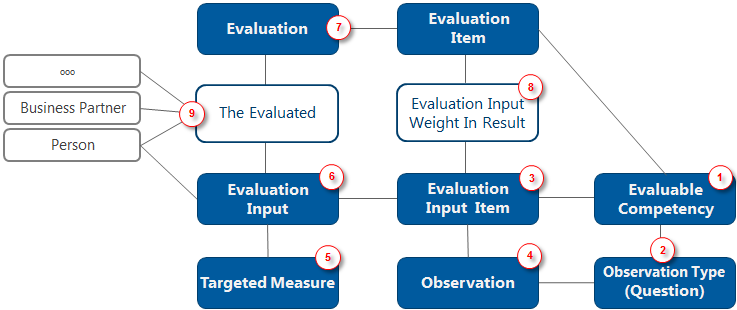Supplier Manager Structure
Supplier Management functionality can be divided into two main areas:
- Consolidation of supplier information and classification of suppliers
- Assessment and evaluation of suppliers
Consolidation of supplier information and classification of suppliers
In the first step, suppliers are registered, all relevant information (including information on prospective suppliers) is gathered and categorized according to several criteria. Information on contact persons and their roles in the supplier relationship is added.
- Suppliers are represented by objects of the Business Partner object type with the 'Partner Type' attribute set to 'Supplier'.
- Business Partner Categories classify business partners according to the area of service they provide.
- Business Partner Graduation classifies business partners according to their importance within supplier relationships.
- Contact persons are assigned to the business partner. Each such assignment is given a Process Role.
- Contact persons assignment is standardized via grouping of Process Roles into Process Relevance Groups.
Assessment and evaluation of suppliers
Supplier assessment and evaluation is a complex functionality based on a number of object types. Please consult the diagram below while reading the functionality description.

- Individual parameters of the supplier relationship are defined as Evaluable Competencies.
- For each evaluable competency, questions designed to evaluate the competency can be specified. Answers to these questions are called 'Observations', the questions themselves are dubbed Observation Types.
- An evaluable competency is akin to a subject on a school report. Actual assessment of the supplier's performance in the given competency is represented by an Evaluation Input Item (aka 'Competency Evaluation Input'). In the school report metaphor, evaluation input items represent individual marks.
- Evaluation provided in the evaluation input item is based on individual Observations, i.e. answers to the questions (observation types) defined for the corresponding evaluable competency.
- An evaluation input can reference one or more Targeted Measures. Targeted measures represent tasks that should be performed to ensure as objective evaluation (i.e. evaluation input item) as possible. To extend the school report metaphor, observations are answers to questions assessing individual areas of the school subject, targeted measures are steps to be taken to get more information (e.g. an oral examination planned for a certain date). In the supplier management context, targeted measure could be a planned personal meeting or an email questionnaire to be sent on a defined date.
- Evaluation Input is a collection of relevant evaluation input items. If we compare evaluation input items to school report marks, then an evaluation input represents the school report. In Supplier Management, it is an assessment of a given supplier by a given evaluator for a given period of time.
- Evaluation is the final product of the process. It sums up information from all evaluation inputs (for a given supplier and a given period of time). Evaluation is calculated from Evaluation Items (aka 'Competency Evaluations'), where each evaluation item sums up evaluations provided (for a given supplier and a given period of time) for each relevant evaluable competency. To finish the school report metaphor: evaluation is like someone reading all school reports of a given student in order to assess how good the student is. Evaluation items are like overall grades given to the student for individual school subjects. (E.g. for a technical university, overall grades in mathematics and physics will be of more importance than other subjects.)
- The contribution of individual evaluation input items to the overall evaluation item is weighted. For instance, evaluation by a more experienced evaluator may be given more weight in the calculation. Weighted averages are also used in other calculations, for example different weights of individual competencies are taken into account when overall evaluation is calculated from evaluation items.
- In Supplier Management, the evaluation is performed for objects of the Business Partner (type 'Supplier') or Person object types. However, the functionality can also be used for other object types (Request, Ticket, Service...). To facilitate this, object type 'The Evaluated' is used to represent the evaluated object. 'The Evaluated' objects point to actual objects of the evaluated object type. In the GUI, catalog: 'Evaluated Objects All' uses 'The Evaluated' to display evaluated objects regardless of their object type.
Over time, many evaluations for one 'The Evaluated' object will exist. In addition to this 1 : N collection of evaluations, the latest evaluation is linked to 'The Evaluated' via a 1 : 1 relation. This makes it possible to always know what the current evaluation of the supplier (or 'The Evaluated', in general) is and use it for display or calculations.